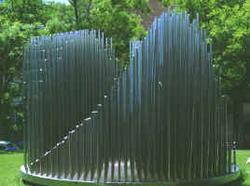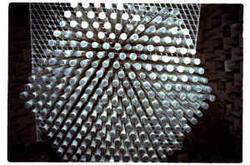Sound Science Imitates Art

Using hanging structures that could have come from a modern art exhibit, a Spanish research team reports they can inhibit a range of sound frequencies in the same way that others have done for electromagnetic waves. “Photonic band gap” materials, also called “photonic crystals,” are periodic structures that forbid light of specific frequency ranges to propagate, just as silicon crystals forbid electrons of certain energies. Now the Spanish team, in the 15 June PRL, demonstrates the first acoustical band gap structure in the audible frequency range, and it may have applications in soundproofing.

Francisco Meseguer, of the Institute of Material Science in Madrid, Spain, had worked on photonic crystals, but over beers one night he was challenged by Jaime Llinares, an engineer at the Technical University of Valencia, to look at the acoustical analogy–an outdoor sculpture in Madrid that seemed to have the right periodic structure. Meseguer, Llinares, and their colleagues published the work in 1995 but did not find a clear band gap (a frequency range where no sound waves could penetrate). Now they have constructed their own “minimalist sculptures,” as they call them–arrays of hundreds of one-meter-long metal bars hung from a rotatable frame–and performed more precisely controlled experiments. They also teamed up with a theory group that could model the two-dimensional system mathematically.
Strategically placing a speaker and two microphones around their echo-free chamber, the authors measured the spectrum of sound transmitted through sculptures with triangular and square symmetries. They found band gaps independent of the sound wave direction as long as the bars were fat enough, just as their theory predicted. But for triangular lattices they were surprised to see a band gap even with slender bars (2 cm diameter) for which the theory predicted a specific set of wave frequencies and directions, known as a “band,” should exist. The team explains the puzzling behavior as resulting from “deaf bands”–wave states that exist in principle, as standing waves, but which cannot be excited from the outside. Although similar effects have been observed with microwaves in photonic crystals, this Spanish team is the first to see such behavior with sound waves.
Meseguer says the structures could form the basis for sound shielding technologies that could, for example, block the rumble of trucks on highways. But for now he is eager to explore sculptures with several different geometries, trying to understand and control their varying band gaps.


